|
Nitrogen
(N) is one of the most abundant elements in plants and animals, as it is a major
component of proteins. The amount of nitrogen required by a crop is large
compared with the natural nitrogen reserves in most soils, and so most crops
respond positively to additional nitrogen, whether from animal manures or
inorganic fertilisers such as urea. However, this pattern does not always hold
for sweetpotato. In some studies, nitrogen application has been reported to
reduce sweetpotato yields. More commonly, the pattern is for low rates of
nitrogen to increase yield to some extent, but higher rates to cause a yield
decline.
The reason for this confusing response is that nitrogen
supply has a strong influence on the distribution of dry matter within the
plant, particularly affecting root growth relative to top growth. When nitrogen
supply is high, plants tend to grow more tops relative to roots. In the case of
sweetpotato, high nitrogen may cause luxuriant growth of the vines at the
expense of storage root yield.
Cultivars vary greatly in the level of nitrogen required to
maximise yield, and in their tendency to reduce yield at higher levels of
nitrogen. In particular, negative responses to nitrogen are more common in
cultivars developed in low-fertility areas where soil amendments are not
traditionally used. One study reported that an application of 60 kg nitrogen/ha
increased yields of three USA cultivars but decreased the yields of three
African cultivars.
There is a common belief in developing countries that
nitrogen fertilisers are bad for sweetpotato. This is unfortunate because
nitrogen deficiency is very common.
Large responses to nitrogen are often obtained on soils which have been heavily
cropped in the past, or those subject to heavy leaching. The response to
nitrogen may be poor, however, if deficiencies of other nutrients such as
potassium are overlooked and left untreated. Sweetpotato tends to respond better
to composts of plant materials which contain high potassium relative to
nitrogen, than to animal manures, which are lower in potassium. However, this
depends on the balance of nutrients present in the soil.
Improved nitrogen nutrition of the crop also leads to higher
protein concentrations in the storage roots, and this may be of considerable
significance in communities which obtain much of their protein from sweetpotato.
In the Kaintiba District of Papua New Guinea, for instance, the mean protein
concentration in storage roots sampled, at 0.62%, was less than half the average
for the South Pacific region, suggesting that these crops were nitrogen
deficient. The protein intake of these Papua New Guinea Highlanders is typically
suboptimal unless supplemented by imported foodstuffs.
Sweetpotato has been shown to form root associations with the
nitrogen fixing soil bacterium Azospirillum brasilense. Inoculation of
crops with the bacterium has been shown to increase the root yield and the
nitrogen concentration in leaf tissue when no nitrogen fertiliser was applied.
The prevalence of such symbiotic
associations in the various regions and environments in which sweetpotato is
grown, and its significance for yield of subsistence crops, have not yet been
investigated.
Deficiency of nitrogen causes dramatic reductions in growth
of sweetpotato plants, and yet it is not easily recognised in the
field, unless there is a well-fertilized crop for comparison. General symptoms are a uniform light green chlorosis
of the leaves, and slow growth resulting in a delayed or sparse ground
cover.
The development of nitrogen deficiency symptoms vary
according to conditions experienced by the crop. When nitrogen is initially
adequate during the establishment phase but becomes depleted during crop growth,
plants may appear normal or near normal in colour and habit, except for
yellowing and premature shedding of older leaves due to remobilisation of
nitrogen from these tissues. In this case, the oldest leaves become
uniformly yellow and slightly wilted. A light brown necrosis may spread from the
tip or margins, but often the leaf is shed before it develops extensive
necrosis. Necrotic tissue is supple rather than brittle.
Alternatively, if nitrogen supply is low throughout the
growth of the crop, no senescence of older leaves may be evident. Symptoms of
chronic nitrogen deficiency include uniformly pale colour, reduced leaf size,
loss of the normal sheen resulting in a dull appearance of the leaves, thin
spindly vines and reduced activity of axillary buds leading to less branching.
In severe cases, small purple-pigmented flecks or ringspots have been observed
on the surface of older leaves of some cultivars.
Increased anthocyanin pigmentation of the young leaves and
especially the leaf veins is a noticeable symptom of nitrogen deficiency, which
has been observed on all cultivars studied. However, it is not unique to
nitrogen deficiency, since phosphorus- or sulfur-deficient plants may show a
similar symptom. This symptom is observed on plants suffering both types of
nitrogen deficiency described above. In cultivars in which young leaves are
normally pigmented, the purple colour is deepened and is retained for longer in
the veins, whereas the leaves of healthy plants change colour uniformly from
purple to green. In cultivars which normally display little or no anthocyanin
pigment, veins of the young leaves become red or purple. In some cultivars, the
pigment may be most obvious on the upper surface of the leaves; in
others, it may be almost absent from the upper surface but distinct on
the lower leaf surface. The red pigmentation usually also
extends to the petiole and stem.
Red veins on young leaves and yellowing of older leaves may
also indicate phosphorus deficiency. However, most leaves on
phosphorus-deficient plants remain dark green. Purple pigmentation on the older
leaves before senescence is seen in some cultivars suffering phosphorus
deficiency but not nitrogen deficiency.
Sulfur deficiency also induces a general chlorosis of the
plant, and may be difficult to distinguish from nitrogen deficiency. Sulfur
deficiency is indicated if the chlorosis is greater on the young leaves than on
the old, if leaf veins are paler than the interveinal tissue, or if red-purple
pigmentation is at least as great on the oldest leaves as on the youngest.
A critical concentration of 4.2% N has been determined for
the 7th to 9th youngest leaves of sweetpotato, on the
basis of vine growth in solution culture. This agrees well with data from
several field studies, when leaves were sampled early in the season (8-10
weeks). However, at least for some cultivars, the nitrogen concentration in
leaves tends to decline with plant age, and it is likely that the critical
concentration varies with the age of the crop. A critical concentration in the
range 3.0-3.8% N may apply to a more mature crop.
The concentration of nitrate-N in the petiole is often used
to assess the nitrogen status of crops. One study quoted nitrate-N
concentrations in the petiole of the sixth leaf of sweetpotato in mid season, as
1500, 2500 and 3500 mg/kg for deficient, intermediate and sufficient nitrogen
status, respectively. However, another found that, while petiole nitrate-N
concentration was sensitive to nitrogen supply, it was highly variable among
cultivars and with age of sampling, and was a poor predictor of root yield.
In the field, fertiliser test strips may be used to confirm a
deficiency of nitrogen, and to distinguish nitrogen from sulfur deficiency. For
example, urea (containing only nitrogen) and sulfate of ammonia (containing both
nitrogen and sulfur) can be applied to separate strips of one or two ridges, at
a rate of about 50 kg N/ha (eg. 1 kg N for a 2 m x 10 m strip). If plants green
up equally with either sulfate of ammonia or urea, it is likely that they were
suffering from nitrogen deficiency; if only the sulfate of ammonia produces a
response, the problem is most likely sulfur deficiency.
Soil nitrogen measurements are difficult to interpret, as
they donít distinguish between sources of nitrogen with differing availability
to plants. As a rough indication, concentrations below 0.1% N (Kjeldahl method)
are regarded as very low, while concentrations of 0.5-1.0% N may be adequate for
maximum crop growth. As an alternative to total soil nitrogen, soil nitrate-N
can be measured. On a sandy-loam with moderate organic matter content, a
critical soil nitrate-N concentration for sweetpotato was estimated to be 37 mg
N/kg soil, sampled 29 days after transplanting.
Cultural control
A sweetpotato crop of 20 t/ha removes approximately 87 kg
N/ha, if roots and vines are harvested. The optimum rate of fertilisation will
depend on the amount of plant-available nitrogen in the soil, and on yield
potential, which may be dictated by the available soil water and rainfall.
Reported recommendations for application of nitrogen fertilisers to sweetpotato
generally lie between 30 and 90 kg N/ha (De Geus, 1967). Overfertilisation with
nitrogen may lead to reduced yields, as it may encourage excessive vine growth
at the expense of the storage roots.
Organic mulches of various materials including foliage from
leguminous trees and animal manure may be used to provide nitrogen to the crop.
Nitrogen also accumulates in organic material during a fallow period,
particularly if the fallow is dominated by leguminous species. This becomes
available to the subsequent crop gradually as the organic material decomposes.
Alternatively, burning the fallow residue rapidly releases the nitrogen from the
organic matter, but much of this is lost to the atmosphere as nitrogen oxides
(NO2, N2O) during the burn. The remaining nitrate is
readily lost through leaching and denitrification, and the long-term effect of
burning is to reduce the supply of nitrogen and other nutrients, as well as
degrading soil physical properties. Nitrogen supply can be increased by growing
a leguminous crop, such as peanut in rotation with sweetpotato, but only if the
crop residues remain in the field.
Nitrogen deficiency is sometimes associated with waterlogging
of the soil. Under anaerobic conditions,
soil bacteria quickly convert soil nitrate into nitrogen gas (N2),
which is lost to the atmosphere. Improved drainage can be achieved by increasing
the height of ridges or mounds, keeping the troughs between them clear of weeds,
and providing adequate channels for excess water to leave the field. Sweetpotato
is sensitive to waterlogging, and crops tend to yield poorly if waterlogging
occurs for even a short period, particularly in the early stages of crop growth.
Therefore, good drainage is necessary regardless of nitrogen supply.
Bourke, R.M. 1977b. Sweet potato (Ipomoea batatas) fertilizer trials on the
Gazelle Peninsula of New Britain: 1954-1976. Papua New Guinea Agriculture
Journal, 28, 73-95.
Bourke, R.M. 1985a. Sweet potato production and research in
Papua New Guinea. Papua New Guinea Journal of Agriculture, Forestry and
Fisheries, 33, 89-108.
Bourke, R.M. 1985b. Influence of nitrogen and potassium
fertiliser on growth of sweet potato (Ipomoea batatas) in Papua New
Guinea. Field Crops Research, 12, 363-375.
Bradbury, J.H. and Holloway, W.D. 1988. Chemistry of tropical
root crops: significance for nutrition and agriculture in the Pacific. ACIAR
Monograph 6, Australian Centre for International Agricultural Research.
Constantin, R.J., Hernandez, T.P. and Jones, L.G. 1974.
Effects of irrigation and nitrogen fertilization on quality of sweet potatoes.
Journal of the American Society for Horticultural Science 99, 308.
Crossman, S.M. and Hill, W.A. 1987. Inoculation of sweet
potato with Azospirillum. HortScience 22, 420-422.
de Geus, J.G. 1967. Fertilizer Guide for Tropical and
Subtropical Farming. Centre d'Etude de l'Azote, Zurich.
D'Souza, E. and Bourke, R.M. 1986a. Intensification of
subsistence agriculture on the Nembi Plateau, Papua New Guinea 1. General
introduction and inorganic fertilizer trials. Papua New Guinea Journal of
Agriculture, Forestry and Fisheries, 34, 19-28.
D'Souza, E. and Bourke, R.M. 1986b. Intensification of
subsistence agriculture on the Nembi Plateau, Papua New Guinea 2. Organic
fertilizer trials. Papua New Guinea Journal of Agriculture, Forestry and
Fisheries, 34, 29-39.
Halavatau, S., Asher, C.J. and Bell, L.C. 1996. Soil
fertility and sweet potato research in Tonga - Nitrogen and Phosphorus. In:
Craswell, E.T. Asher, C.J. and OíSullivan, J.N. (eds.) ACIAR Proceedings
No.65: Mineral nutrient disorders of root crops in the Pacific. pp 58-64.
Harvey, P.W. and Heywood, P.F. 1983. Twenty-five years of
dietary changes in Simbu Province, Papua New Guinea. Ecology of Food Nutrition
13, 27-35.
Heywood, P.F. and Nikikus, M. 1982. Protein, energy and
nutrition in Papua New Guinea. In: Bourke, R.M. and Kesavan, V. (eds.),
Proceedings of the Second Papua New Guinea Food Crops Conference, Department of
Primary Industry, Port Moresby. pp 303-324.
Hill, W.A., Bacon-Hill, P., Crossman, S.M. and Stevens, C.
1983. Characterization of N2-fixing bacteria associated with sweet potato roots.
Canadian Journal of Microbiology 29, 860-862.
Hill, W.A. and Bacon, P. 1984. Fertilizer N use efficiency
and associative N2-fixation of sweet potato. In: Proceedings of the Sixth
Symposium of the International Society for Tropical Root Crops, CIP Lima Peru,
pp 535-542.
Jackson, D.C. 1972. Some preliminary results of fertiliser
trials with sweet potatoes (Ipomoea batatas Poir). Crop Production 1, 35-37.
Jones, A. and Bouwkamp, J.C. 1992. Fifty years of cooperative
sweetpotato research 1939-1989. Southern Cooperative Series, Bulletin No. 369,
Louisiana Agricultural Experiment Station, Baton Rouge, USA.
Kimber, A.J. 1976. Some factors influencing the protein
content of sweet potato. In: Willson, K. and Bourke, R.M. (eds) Proceedings of
the 1975 Papua New Guinea Food Crops Conference, Department of Primary Industry,
Port Moresby, pp 63-74.
Leonard, O.A., Anderson, W.S. and Gieger, M. 1949. Field
studies on the mineral nutrition of the sweetpotato. Proceedings of the American
Society for Horticultural Science 53, 387-392.
Lorenz, O.A. 1965. Better vegetable yields and quality with
plant analysis. Plant Food Review 11, 2-4.
Mascianica, M.P., Bellinder, R.R., Graves, B., Morse, R.D.
and Talleyrand, H. 1985. Forecasting of N fertilization requirements for sweet
potatoes. Journal of the American Society for Horticultural Science 110,
358-361.
Mortley, D.G. and Hill, W.A. 1990. Sweetpotato growth and
nitrogen content following nitrogen application and inoculation with
Azospirillum. HortScience 25, 758-759.
Navarro, A.A. and Padda, D.S. 1983. Effects of sulfur,
phosphorous and nitrogen application on the growth and yield of sweet potatoes
grown on Fredensborg clay loam. Journal of the Agricultural University of Puerto
Rico 67, 108.
OíSullivan, J.N., Asher, C.J. and Blamey, F.P.C. 1997. Nutrient Disorders
of Sweet Potato. ACIAR Monograph No. 48, Australian Centre for International
Agricultural Research, Canberra, 136 p.
Purcell, A.E., Walter, W.M., Nicholaides, J.J., Collins, W.W.
and Chancy, H. 1982. Nitrogen, potassium, sulfur fertilization, and protein
content of sweet potato roots. Journal of the American Society for Horticultural
Science, 107, 425-427.
Scott, L.E. and Bouwkamp, J.C. 1974. Seasonal mineral
accumulation by the sweet potato. HortScience 9: 233-235.
Spence, J.A. and Ahmad, N. 1967. Plant nutrient deficiencies
and related tissue composition of the sweet potato. Agronomy Journal 59, 59-62.
Villareal, R.L., Tsou, S.C.S., Lin, S.K. and Chiu, S.C. 1979.
Use of sweet potato (Ipomoea batatas) leaf tips as vegetables. II.
Evaluation of yield and nutritive quality. Exptl. Agric. 15, 117-122.
Walker,
D.W. and Woodson, W.R. 1987. Nitrogen rate and cultivar effects on nitrogen and
nitrate concentrations of sweet potato leaf tissue. Communications in Soil
Science and Plant Analysis 18, 529-541.
Contributed by:
Jane
O'Sullivan |
Characteristics
and occurrence
Symptoms
Confusion
with other symptoms
Diagnostic
tests
Management
References
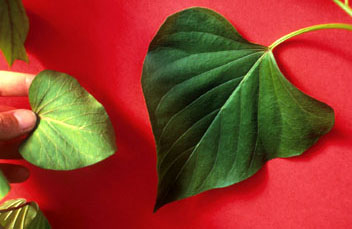
Small, pale, dull nitrogen-deficient leaf (left)
compared with a healthy leaf (J. O'Sullivan).
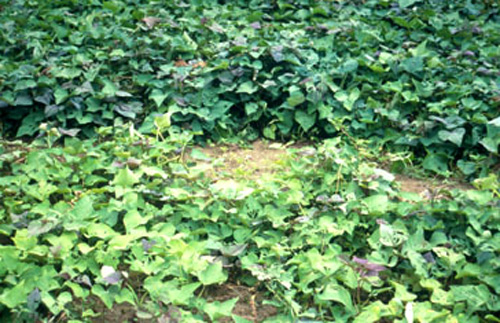
General light green colour and sparse
canopy, compared with N-fertilized crop behind.
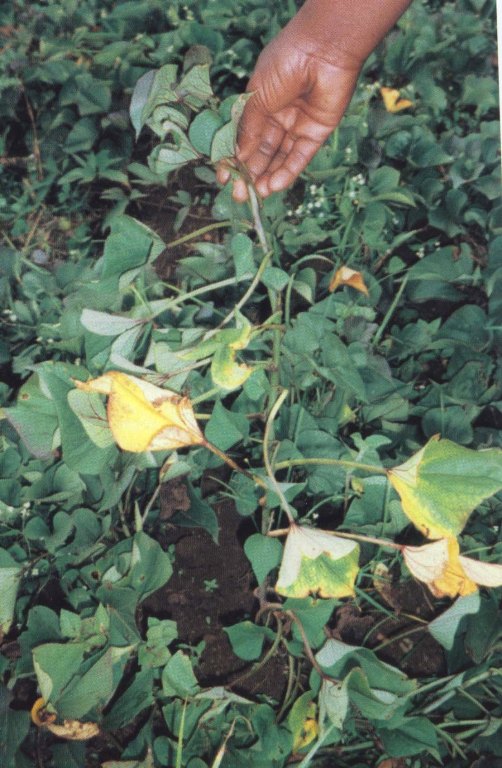
Yellowing, wilting and drying up of oldest leaves, and purple veins
on young leaves are common symptoms (J. Low).
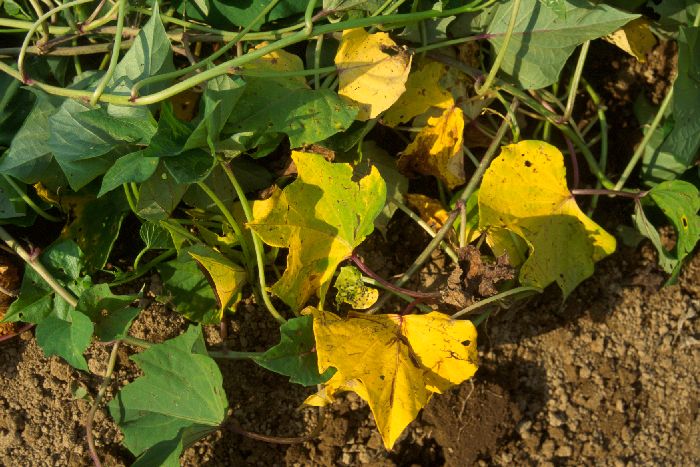
Typically oldest leaves turn completely yellow
before necrosis spreads. Numerous yellow leaves on a young crop
are indicative of N-deficiency (J. O'Sullivan).
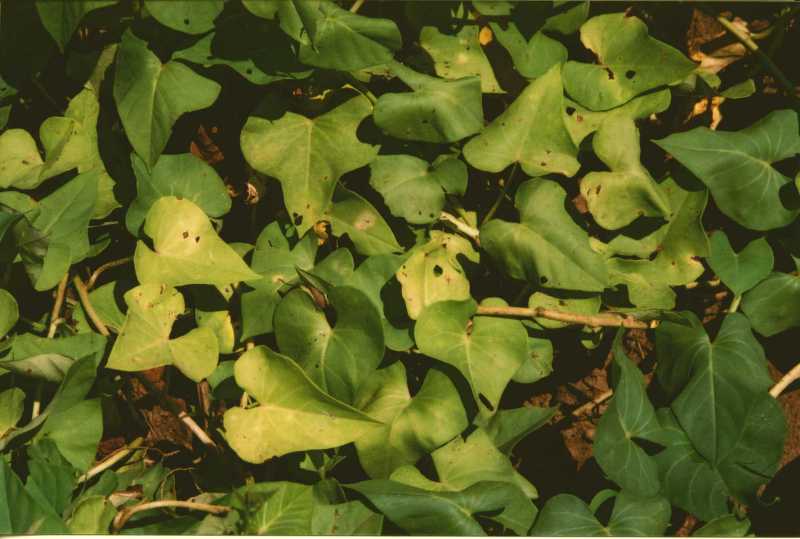
A crop with chronic N deficiency, showing small,
dull leaves and sparse ground cover, but few yellow leaves (J.
O'Sullivan).
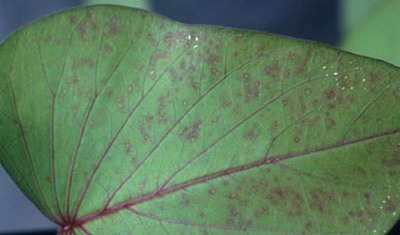
Small purple ringspots on mature leaves is occasionally seen (J.
O'Sullivan)
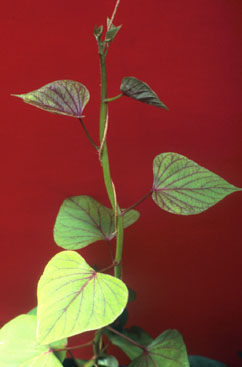
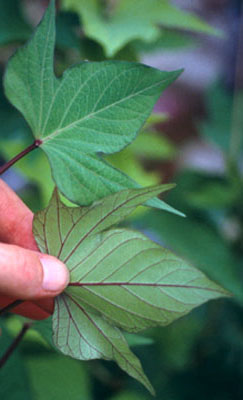
Red or purple pigmentation of young leaves, especially
veins and petioles, is a common response to N deficiency, and may
be apparent on upper or lower surface (J. O'Sullivan).
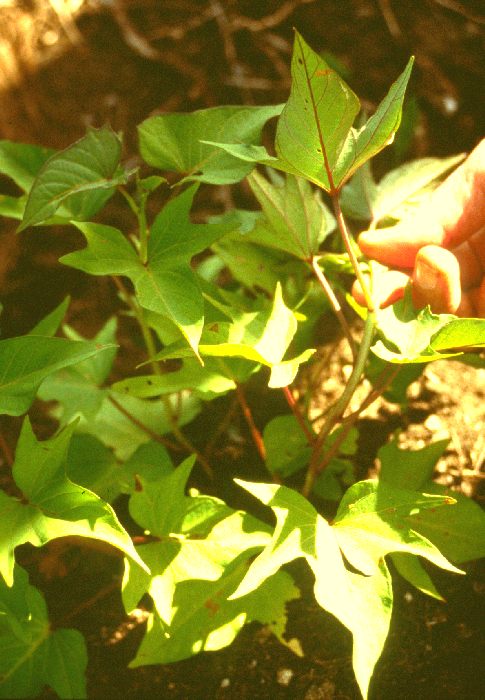
Small light green leaves and red veins and
petioles on a young N-deficient plant (J. O'Sullivan).
|

